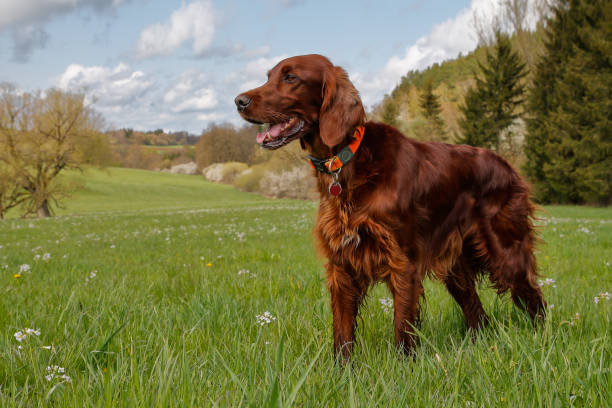Irish Setter

Breed History:
The Irish Setter originated in Ireland in the 18th century, developed as a gun dog specialised in locating game birds by “setting” or crouching low in the field. Early setters came in a variety of colours, but by the mid-19th century, a deep, solid red coat became the hallmark of the breed, favoured by hunters and fanciers alike.
Irish Setters were refined by breeders such as the Marquis of Waterford and Red Hugh O’Donnell, who selected for both field ability and striking appearance. By the late 1800s, they gained popularity in both Europe and the United States as sporting and show dogs. Recognised by the AKC in 1878, the breed has remained a beloved companion, show dog, and working hunter ever since.
|
Gender |
Height |
Weight |
|
Male |
69 cm |
29-34 kg |
|
Female |
63 cm |
25-30 kg |
Size – Medium-Large
Life Expectancy: 12–15 years

Breed Appearance:
The Irish Setter is a tall, graceful, and athletic dog known for its flowing, mahogany red coat and elegant profile. The coat is flat and glossy with feathering on the chest, belly, tail, and legs, adding to the breed’s refined appearance.
The head is long and lean, with dark almond-shaped eyes and long ears that hang close to the cheeks. The Irish Setter has a deep chest, strong limbs, and a level topline. It moves with light, effortless strides, showcasing both endurance and style.
Breed Type – Sporting/Gun Dog:
Bred to work closely with hunters, the Irish Setter is a sociable and affectionate companion that thrives on human interaction. It is friendly, outgoing, and generally good with children, other dogs, and strangers.
The breed’s temperament is playful, energetic, and cheerful, making it a favorite in active families. While not a guard dog, it will alert bark but rarely shows aggression. It is happiest when included in all aspects of family life.

Training:
Irish Setters are intelligent but can be independent and easily distracted, especially when young. They benefit from early training and positive reinforcement methods that keep learning fun and rewarding.
Consistency and patience are key. While eager to please, this breed matures slowly and can be mischievous without proper boundaries. It excels in obedience, agility, and hunting trials, especially when training is paired with play and exercise.
Health & Care:
Irish Setters are generally healthy, but may be predisposed to certain conditions, including:
-
Hip dysplasia
-
Progressive retinal atrophy (PRA)
-
Epilepsy
-
Hypothyroidism
-
Gastric torsion (bloat) – a serious emergency
Regular veterinary care, a proper diet, and awareness of bloat symptoms are crucial. Reputable breeders test for inherited conditions.

Living Conditions:
This breed is not well-suited to apartment living unless given ample daily exercise. It thrives in homes with fenced yards, open spaces, or rural settings where it can safely run and explore.
The Irish Setter does best in homes where it is not left alone for long hours, as it craves companionship and can become destructive when bored or lonely. It prefers mild to cool climates due to its coat.
Exercise:
An energetic and lively dog, the Irish Setter requires at least 1.5 to 2 hours of exercise daily. Activities should include:
-
Off-leash running or play
-
Fetch and interactive games
-
Long hikes or jogs
-
Fieldwork or dog sports
Mental stimulation through scent games or puzzle toys also helps keep the breed engaged and content.
Grooming:
The Irish Setter’s long, silky coat needs regular maintenance:
-
Brush 2–3 times per week to prevent tangles and remove debris
-
Trim excess feathering on feet and ears as needed
-
Bathe occasionally or after muddy outings
-
Clean ears and brush teeth regularly
-
Monitor for ticks or skin issues in feathered areas
Shedding is moderate but can be managed with consistent grooming.

Advantages:
-
Stunning appearance with a rich red coat
-
Friendly and gentle with children and strangers
-
Excellent hunting and field abilities
-
Affectionate and eager to be part of the family
-
Responsive to positive training
-
Energetic, athletic, and ideal for active homes
Disadvantages:
-
Requires significant daily exercise and stimulation
-
Can be distracted or slow to mature in training
-
Not ideal for apartment or sedentary living
-
May suffer separation anxiety if left alone too long
-
Prone to bloat and other health concerns
-
Coat needs regular grooming and maintenance

